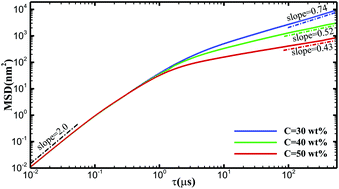Controlled release of entrapped nanoparticles from thermoresponsive hydrogels with tunable network characteristics
Abstract
Thermoresponsive hydrogels have been studied intensively for creating smart drug carriers and controlled drug delivery. Understanding the drug release kinetics and corresponding transport mechanisms of nanoparticles (NPs) in a thermoresponsive hydrogel network is the key to the successful design of smart drug delivery systems. We construct a mesoscopic model of rigid NPs entrapped in a hydrogel network in an aqueous solution, where the hydrogel network is formed by cross-linked semiflexible polymers of thermoresponsive poly(N-isopropylacrylamide) (PNIPAM). By varying the temperature crossing the lower critical solution temperature of PNIPAM, we can significantly change the hydrogel network characteristics. We systematically investigate how the matrix porosity and the nanoparticle size affect the transport kinetics of NPs at different temperatures. Quantitative results on the mean-squared displacement and the van Hove displacement distributions of NPs show that all NPs entrapped in the smart hydrogels undergo subdiffusion at both low and high temperatures. For a coil state, the transport of NPs in the hydrogels can be enhanced by decreasing the matrix porosity of the polymer network and NPs' size. However, when the solution temperature is increased above the critical temperature, the hydrogel network collapses following the coil-to-globule transition, with the NPs tightly trapped in some local regions inside the hydrogels. Consequently, the NP diffusion coefficient can be reduced by two orders of magnitude, or the diffusion processes can even be completely stopped. These findings provide new insights for designing controlled drug release from stimuli-responsive hydrogels, including autonomously switch on/off drug release in response to physical and chemical stimuli.



 Please wait while we load your content...
Please wait while we load your content...